Articles
Narrating Personal and Collective History in Heritage
Tourism:
Conflicting Representations of the São Domingos Mine and Community
Maria
João Ramos P. SilvaBeja Polytechnic Higher Institute, Portugal
Résumé
Cet article explore les complexités et les contradictions en même temps que le potentiel croissant du tourisme pour les sites du patrimoine industriel. Il examine la manière dont les sites de patrimoine industriel peuvent permettre, si ce n’est favoriser, la communication d’histoires personnelles et collectives et les expériences d’artisanat et de modes de vie du passé, en même temps que l’oppression, l’exploitation et l’abandon qui vont souvent de pair avec l’industrie. Cet essai se concentre sur la réaffectation continue d’une destination touristique de patrimoine industriel, celle d’un ancien village et complexe minier du Portugal. Dirigée par une compagnie minière anglaise au milieu du XIXe siècle, la mine est restée en activité jusque dans les années 1960. Trois représentations de l’histoire de la mine et de la communauté de S. Domingo sont analysées et comparées, nommément deux expositions préparées pour le 150e anniversaire de la fondation de la mine, une exposition de peinture, photographie et multimédia et un livre écrit et publié à compte d’auteur par un ancien mineur.Abstract
This paper explores the complexities and contradictions, as well as the progressive potential of industrial heritage tourism sites. It considers how industrial heritage sites may enable, if not foster, the communication of personal and collective stories and experiences of past crafts and ways of life, along with the oppression, exploitation and abandonment that often comes with industry. The focus of the essay is the ongoing recast into an industrial heritage tourism destination of a former mining village and complex in Portugal. Built and run by an English mining company during the mid 19th century, the mine operated until the 1960s. Three representations of the history of the S. Domingos mine and community are analyzed and confronted, namely two exhibitions prepared for the 150th anniversary of the founding of the mine, a painting, photography and multimedia exhibition, and a book written and self published by a former miner.1 De-industrialization is perhaps the most visible and locally perceived effect of the "process of ... international restructuring of capitalism" (Corner and Harvey 1991: 3) which has been responsible for profound economic, social and cultural transformations, reconfiguring geographies on a truly global scale (Robins 1999: 17). In recent decades, we have witnessed the closing and dismantling of textile factories, steel plants, mining operations and other types of industrial production. Mostly based in North American or Western European countries, such industries are then relocated to lower-wage countries for the purposes of cost-reduction and profit-maximization. A related discernible trend in contemporary societies has been the "commoditization of ... almost every aspect of existence" (Kopytoff 1986: 86-87), particularly culture. This was first signalled by the Frankfurt School (Kellner 1997: 13) and gains momentum in the (perhaps unparalleled) prominence of the culture and creative industries, both in academia and in government and media discourses.
2 Given the perceived potential of a tourism industry whose "exponential growth" is itself part of the "global processes of commodification" (Meethan 2001: 5), the "regeneration" of deactivated mines and other industrial wastelands has often centred on their conversion into tourist sites. This geographical reconfiguration is not just spatial but also symbolic: "as territories are transformed, so too are the spaces of identity" (Robins 1999: 17). Globalization has paradoxically brought about a renewed sense of the local (what Robins (1999: 23) calls "cultural localism") and added pressures to ideas of the nation. In such context, former (usually derelict) industrial premises have been transformed into tourist attractions and the obsolete tools of the workers given a "second life" (Kirshenblatt-Gimblett 1998: 7) by being put on display as "metonymic sign[s]" (Urry 2002: 117) of a bygone industrial age. At the same time, the broken working-class villages and communities have been (and continue to be) redefined and refashioned as objects of the tourist gaze, as part of a common national, and sometimes world, heritage.
3 Against the background of these ongoing global transformations, this paper explores the complexities and contradictions of industrial museums and heritage sites as they are ideologically mobilized in the reconstitution of the nation and/ or the region in response to new pressures and challenges, while also allowing for the narration of alternative—even oppositional—individual and collective experiences, memories and histories, and the questioning of dominant discourses on national history and identity or on the current post-industrial nature of contemporary societies. Heritage is fundamentally realized through the display of objects, images and texts. The question of how material and visual culture interplay to create, foster, or otherwise question and oppose these discourses is therefore of central importance and will be directly addressed in this monograph.
4 The paper starts with a preliminary consideration of how and why heritage, tourism and museums have recently come to intersect in fundamentally new ways in academic debates. This entails taking a brief look at the modern history of what Stuart Hall (2005) calls "the heritage" and at how objects, images and texts signify heritage in museum displays, particularly from a constructionist view of representation (Hall 1997; Lidchi 1997). Following a case-study approach, the paper makes use of the ongoing conversion of a (former) Portuguese mining village and complex into an industrial heritage tourism destination to analyze three representations, or representational systems as Lidchi (1997) would say, of the history of the São Domingos mine and community—namely, the exhibitions organized by the local council to commemorate the village’s 150th anniversary, the joint painting, photography and multimedia exhibition by Helena Lousinha, António Cunha and Pierre dos Santos and an unconventional Guidebook of the Mine, written and self published by António Martins, a former miner. This analysis, framed by a brief review of some relevant questions raised in the context of the so-called "heritage debates," will help illuminate some of the limitations and contradictions of the commemorative exhibitions and it will consider the ways in which the relationship between material and visual culture can either create and sustain or else modify and oppose dominant representations of the national heritage for global tourism purposes.
Heritage and the (Re)constitution of the Nation/Region
5 One of the most brilliant social and cultural analysts of the 20th century, Raymond Williams (1993: xvii), demonstrated that words are "record[s] of important and continuing reactions to ... changes in our social, economic and political life, and may be seen ... as a special kind of map by means of which the nature of the changes can be explored."1 The word heritage can profitably be looked at as such a map. Being a cultural construct, heritage has no intrinsic—positive or negative, enabling or harmful—value or potential. In her exploration of the concept’s history, Jo Littler (2005: 2) has shown that "‘heritage’ is historically specific, culturally contingent and philosophically debatable." In its dominant modern meaning, however, the term has been deeply interwoven in the constitution and re-constitution of national identity, creating a type of canon of select(ed) "works and artefacts" (Hall 2005: 23), "invented traditions" (Hobsbawm 1999: 69) or "selective tradition" (Williams 1992: 49). "A shared national identity ... depends on the cultural meanings, which bind each member individually into the large national story. ... National Heritage is a powerful source of such meanings" writes Hall (2005: 24).
6 In his discussion of national culture in global contexts, Kevin Robins (1999:17, 22-23) has shown that the global transformations effected by the "international restructuring of capitalist economies" have brought about a renewed significance of regions and localities, making them direct and competing players—and production units—in the global economic system. Tradition and heritage have therefore been taking on new roles, not only at the national but also at the regional or local levels, as they are seen to "enhance the ‘quality of life’ of particular places and make them attractive locations for investment" (26)—and tourism.
7 The concept of heritage thus changed in two major related ways: first, its raison d’être shifted from preservation to commodification. "That which is inherited from the past" (Corner and Harvey 1991: 14) is now geared primarily for a thriving heritage industry which, according to Littler (2005: 4) is "packaged in a variety of ways, used to sell goods, services, organizations, tourism and national identity." Morley and Robins (2001: 8) write that heritage "has become a key word in our national vocabulary; it is what Britain sells...." In this context, Kirshenblatt-Gimblett defines it as "a mode of cultural production in the present that has recourse to the past" (1998: 7).
8 Secondly, the mass production of the newly invented heritage attractions for a booming tourist industry in turn required the expansion of the canon of "heritage-able" sites, so that, as Urry noted, "some of the most unlikely places have become centres of a heritage-based tourist development" (2002: 94). In the specific context of de-industrialization, this meant the incorporation of urban industrial facilities and their inescapable working-class history and popular culture, often purged of its non-conformist and oppositional attributes, into the canon of sites and dominant ideas which defined the nation and its heritage— creating a harmonious, coherent and abridged (tourist friendly) version of the national history. In this context, Hall (2005: 25) calls for the need to look at heritage as "a discursive practice ... one of the ways in which the nation slowly constructs for itself a sort of collective social memory."
Narrating the Past in the Museum: Objects, Images and Texts
9 "Heritage ... depends on display to give dying economies and dead sites a second life as an exhibition of themselves" (Kirshenblatt-Gimblett 1998: 7). Whatever its present- or future-oriented purposes, heritage realizes itself through material and visual culture, through the display of objects, images and texts.2 In the specific case of industrial heritage, "deactivated" and often fragmented (useless) machinery, tools and a multitude of other ordinary objects related to the everyday work, domestic or leisure spheres of industrial workers and communities are imbibed with new value, uses and meanings. They can be seen as examples of what Appadurai (1986: 28) calls "commoditization by diversion, where value ... is accelerated or enhanced by placing objects and things in unlikely contexts."
10 In this process of re-contextualization or "singularization" (Kopytoff 1986: 73) objects become special, taking on what Kirshenblatt-Gimblett calls "the museum effect" (1998: 51). Objects thus displayed are often believed to possess some intrinsic value or power, which makes the viewer’s experience relevant, "extra-ordinary." Their endurance and tangibility are taken as irrevocable proof of their authentic and objective character. "Their physicality delivers a promise of stability" (Lidchi 1997: 162). This, however, becomes difficult and highly problematic, as objects are culturally constituted signs: their meanings are socially and historically contingent. Like words, they are polysemantic and real "palimpsests of meanings" (Lidchi 1997: 167), which they acquired through their sometimes long social lives. This is undoubtedly one of the reasons they appeal to us, for "the sign which carries meaning is able to do so because, unlike ourselves who must die, it bears an ‘eternal’ relationship to the receding past, and it is this that we experience as the power of ‘the actual object’" as Susan Pearce (1994: 25) stresses. At the same time, however, the multiple or indeed inexhaustible potential meanings that objects latently encapsulate stand dialectically toward their tangibility, as a source of permanent destabilization (Lidchi 1997: 162; Pearce 1994: 26).
11 Material and visual culture have therefore to be conceived and studied as signifying systems and practices which, as Christopher Tilley (1994: 70), argues "can be used for transforming, storing or preserving social information."3 They work as non-verbal, pictorial languages, as "a silent form of writing and discourse" (ibid.), they are made to signify in complex mediated ways: exhibited objects and photographs produce meanings not individually, but through their interrelations (ibid.). The question of context, and of the "representational frameworks" (Bennett 1988: 84) employed in the exhibition processes, also referred to as "the politics of display" (Macdonald 1998), are thus decisive for the meanings that objects, images and texts (re)produce. Their selection, classification and arrangement has "political effects" (Sandell 2002: 8); it crucially influences the ways in which museums construct or help reinforce certain official or dominant narratives or discourses, for instance, of the national past or heritage. In this context, Kirshenblatt-Gimblett contends that "...display not only shows and speaks, it also does" (1998: 6), and Hall, following Foucault, emphasizes the idea that "physical things and actions exist, but they only take on meaning and become objects of knowledge within discourse" (1997: 45).
12 The polysemic nature of material and visual signs is simultaneously the source of their polyvocality, of their multiple symbolic possibilities. Three deeply interrelated ideas should be emphasized here: first, that "an object ... has no ultimate or unitary meaning that can be held to exhaust it. Rather ... multiple and sometimes contradictory meanings" (Tilley 1994: 72). Second, that the production of meaning does not reside in the objects and images themselves, but lies in the virtual interplay between the object and the realization by the viewer (Pearce 1994: 26; Sandell 2002: 15). Third, interpretation is itself extremely complex, depending on a multiplicity of imponderable factors, such as the viewer’s socio-cultural background or disposition, which makes "decoding" both a selective (Pearce 1994: 26) and highly unpredictable process (Sandell 2002: 15). In this context, Patricia Davison (2005: 193) notes that "museums hold and shape memories, but they cannot contain them" and Samuel (1999: 180) argues that "there are no historical propositions which are insulated from contrary readings."
São Domingos Mine: the (Mis)fortunes of an Industrial Past and the Promise of Tourist (Re)development
13 The history of the São Domingos Mine and community and the three exhibitions that were recently held there provide an interesting case-study to explore the concepts laid out above. The village of São Domingos, or São Domingos Mine, is located in south Alentejo, Portugal, one of the poorest regions of the European Union. It is in a hilly area that contrasts heavily with the pervasive picture postcard image of Alentejo’s endless plains. It is off the beaten track from the main roads leading south to Algarve, north to Lisbon and east to Spain, but only eighteen kilometres from the Guadiana River that flows into the Atlantic Ocean. This strategic position was once the determining factor for the development of the site.
14 The village was built from scratch by the English mining company Mason and Barry Ltd. in the late 1850s and 1860s, reproducing the urban development patterns of contemporary English industrial towns. Today, a huge crater filled with blood-red acid waters is what remains of this once world-class pyrite mine, exploited since ancient times.4 The São Domingos mining enterprise has been considered one of the first and most important industrial ventures ever undertaken in Portugal: over a 112-year period of activity, it produced about 25 million metric tonnes of copper ore, which were sold in Swansea, Bristol, Newcastle, Glasgow and Ipswich (Guimarães 1996; Rego 2004b) to fuel Britain’s industrial development. By the 1960s, the ore deposits were nearly exhausted and further exploration ceased to be profitable.
15 Through a shady and tortuous process of capital conversion and diversion, involving the setting up of about ten new companies based in Portugal and in England, Mason and Barry (listed in the London Stock Exchange since 1881) redirected its operations to the emerging real estate business in Algarve. After dismantling and selling all the equipment and scrap metal from the mining complex, Mason and Barry declared bankruptcy and left São Domingos. The consequences for the working-class community that had developed around the mine were catastrophic. Deprived of state help or alternative local employment opportunities, most people had no choice but to leave São Domingos. Some settled in Lisbon’s industrial suburbs; others emigrated to northern European countries, such as France, Belgium or the Netherlands. Only the elderly and those incapacitated by mining illnesses and injuries stayed—subsisting on the financial assistance of expatriate relatives.
16 After decades of almost complete disregard and public oblivion, mostly due to its complicated legal status,5 the village, which according to the mayor of Mértola, "had almost disappeared from the map" as noted in the February 12, 2004, edition of Alentejo Popular, became an object of renewed interest and attention by the local council, mainly because of its perceived tourism potential. In 2004, the 150th anniversary of the mine’s "discovery"6 was celebrated with a series of concerted actions and the announcement of various redevelopment projects, which again, the mayor suggested, would signal the turning point in the long process of the village’s economic decline. Under the "Roots in the Past, Eyes on the Future" slogan, public water supply and drainage systems were developed by the local authorities. Other municipal projects, such as the reconstruction of several derelict public buildings, the environmental remediation of contaminated areas, the opening of a model of a miner’s home and the impending listing of the mining village and complex as "National Heritage"—were also widely advertised in the regional press.
17 Popularly known as The Palace, the former residence of the mine’s director was rebuilt, expanded and converted into a modern five-star country-house hotel. The commemorations of the village’s anniversary, which had the declared objective of fostering the village’s (mainly tourist) redevelopment,7 included the erection of a miners’ monument, the edition of a historical photograph book and a temporary exhibition. The Miners’ Monument, commissioned by the local council to Jorge Castanho, a local sculptor, who donated it to the village "in memory of all miners" (Castanho 2004), was inaugurated in April by then Portuguese President Jorge Sampaio. The event was widely covered by the national media. The President addressed the residents from the former bandstand and was reported to have emotionally praised Alentejo’s "sense of community" and expressed his wish for a "more equal and cohesive country" according to the April 17, 2004, online edition of Público.
The Commemorative Exhibitions: São Domingos Mine: 150 Years of History (2004) and The Face that Gazes at the Soil (2005)
18 The São Domingos Mine: 150 Years of History exhibition was organized by the local council and held in the former (and partially renovated) theatre. It opened on the January 31, 2004, and was scheduled to close in September. By April, more than 10,000 people from all of Portugal had visited the exhibition. Because of the high visitation rate, the council decided to extend the exhibition’s run until the end of December. The aim of the exhibition, clearly stated in the accompanying leaflet, was "to record both the individual and the collective memory of the São Domingos miners, the town’s thousand stories", and "the names of anonymous people with names" (Rego 2004a). The leaflet appealed to the visitor’s capacity to imagine the "thousand stories" underpinning the mining artifacts and described the exhibition as the first step in a process of "revaluation and dignification of this village’s memory" (ibid.). The exhibition was to culminate in the creation of a mining museum.
19 The exhibition was spread among three rooms. The first room was dominated by a welcome desk on the right, where visitors were given the exhibition leaflet. Several books connected to the history of the mine were displayed for sale in this area, among them the newly published Memory Photograms, containing several black-and-white photo and postcard reproductions of the village, the mining complex, the railway, the port and the mining population. Only two objects were displayed in this room: the 1854 legal document where the Piedmontese miner, Nicholas Biava, laid claim to the mine and (below that) a rusty fragment of an unidentified industrial tool or machine. The meaning of these two objects was explained in the exhibition leaflet: they represented "the beginning and the end of this gigantic mining complex, which has been stripped of almost everything. ... [t]he ore, the equipment, the structures, the men..." (Rego 2004a).
20 The display in the second room consisted of full-length posters, geological plans and maps describing the formation and characteristics of the São Domingos ore deposits, together with several glass-cased rock, ore and slag specimens. The third, and main (theatre), room was dimly lit and housed a display of particularly emblematic mining artifacts. A wagon and the first "cage" that "took down thousands of men and returned them to the surface" (Rego 2004a), together with pickaxes and hammers, were placed on an elevated platform in the centre of the room (Fig. 1). Around them, smaller tools and objects were displayed in different cases depending on the mining department to which they originally belonged. However, there was little or no information about their provenance or the contexts in which they were originally used.
21 On the walls, full-length glossy posters with a great deal of text told the general history of the mine, accompanied by reproductions of old photographs of the site, the railway and the steam locomotives that drew "millions of tons of ore to the port of Pomarão" (Rego 2004a).8 Next to the stage, a glass case contained musical instruments of the working-class philharmonic orchestra, founded in the late 19th century, which "coloured Sunday afternoons ... and livened up parties and commemorations" (Rego 2004a). Oddly placed among them, a cricket ball was the sole object reflecting the presence and life style of the British senior staff who resided in the community while the mine was operated (Fig. 2). A series of old pictures —"which our eyes will never be able to see" (Rego 2004a)—of the site and villagers during the heyday of the enterprise completed the exhibition.
Fig. 1 São Domingos Mine: 150 Years of History exhibition – main room; back cover of Cadernos de Mértola (2004) (courtesy of Câmara Municipal de Mértola).
Display large image of Figure
1
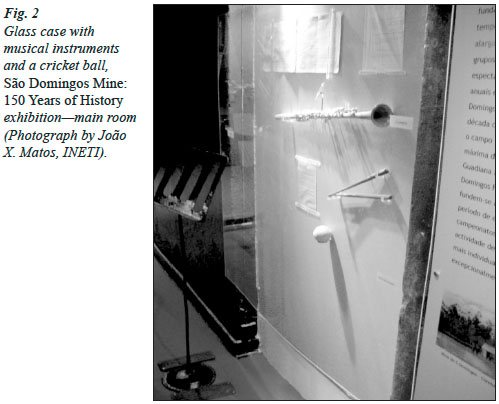
Display large image of Figure
2
22 Given perhaps the success of the event, another exhibition, entitled The Face that Gazes at the Soil, followed in 2005 in the theatre’s main room. Deprived of a catalogue or leaflet, this exhibition overtly addressed the exploited labour and poor living conditions of the workers. It also dealt with the workers’ political institutions and their activism, describing some crucial moments in the miners’ struggle for better working and living conditions. This was done by means of several medium-sized glossy posters with long, single-spaced texts accompanied by old photographs that had been digitized. Although the layout was similar to that of the first exhibition, only a small number of artifacts were exhibited. Those few items were not contextualized and were randomly placed next to or below the text posters, which completely overshadowed the objects. The centrepiece of the exhibition was not the artifacts or the posters, but the black-and-white documentary film, Biography of a Mine—with English subtitles—projected on a big screen over the stage of the former theatre.
Gazes Upon a Place Travelling Exhibition
23 A third exhibition, S. Domingos Mine: Gazes Upon a Place travelled the whole Alentejo region for a period of more than a year. Not an "official" commemorative exhibition, it started in June 2006 in Montemor-o-Novo and finished in São Domingos in November 2007. Unlike the commemorative exhibitions, this event received little attention from the local authorities or from the local and regional media.9 Gazes Upon a Place was a joint exhibition of three artists who had been profoundly influenced by the mine: its people, its history, its distinctive spaces and landscapes (Cunha et al. 2006). According to the curator, the exhibition’s declared goal was "to reinstate the debate on the future of this unique, long forgotten memory-space, which is simultaneously a witness to Man’s archetypal activities, to the history of Portuguese industrialization and of a working-class culture that marked countless personal destinies" (Rosenthal 2006). Pierre dos Santos’s film (a sound and photo installation), Helena Lousinha’s paintings and António Cunha’s photographs make up a striking and poignant evocation of the past and present São Domingos and of its people.
24 Pierre dos Santos’s six-minute image and sound piece recreates the rugged textures and colours of the body of ore, a black hole seen from above, from space, the digging of deeper and deeper tunnels, like a giant, black, blood-shot and copper-coloured arm and hand that tore the earth (Fig. 3). The sound evokes the history of this mining venture: the rhythmic sound of the mining tools against the rock, gradually superimposed by the deafening cacophony of industrial equipment during the pinnacle of the mining operation. At times, these sounds are interspersed with children’s voices and laughter or men’s chants. The end of the mine’s life is symbolically depicted by the silencing of the machines and the fading human grief-stricken lament which seems to reverberate through the walls of the mine’s bottom.
25 Helena Lousinha’s paintings evoke primarily the human suffering throughout the whole history of the mine, the human destructiveness of both the mining work and the lack of it—"the end of the dream" in the painter’s own words (Cunha et al. 2006). The year the company declared bankruptcy (1968), is imprinted on the bottom right corner of each painting’s metal base. Ovens (Fig. 4) poignantly depicts the physical arduousness of the work at the sulphur factory, under the scorching sun and suffocating heat of Alentejo, breathing in the sulphur smoke. The bulky but bent and empty-handed human figure evokes despair in the face of, on one hand, the subhuman working conditions and, on the other, of the lack of work when the factory closed. The rising smokeless chimneys resemble the stiff legs of an animal corpse lying on its back. Mine Pit depicts the miners’ silhouettes standing out against the blackness of the mine. The use of the colour red symbolizes the frequent mining accidents which went unrecorded in the administration’s annual reports, or the wounds caused by the acid water that constantly dripped from the walls. Another untitled piece shows the open-cast pit flooded with dark, copper-coloured acid water, an enduring environmental problem, and what seems to be a human figure, dangerously swinging or free falling, painted in bright red against the whitewash of the typical Alentejo’s house and the contour of a window. A metaphor for suicide?
26 António Cunha’s photographs focus on the present-day population of São Domingos. The strength of his images lies in his capacity to give the residents a voice, to make them "speak." The traumatic attachment to the mine’s past life is strikingly evident in the recurring gesture of pointing to the mine’s location (Fig.5).10 Cunha’s camera also captures the human bits and pieces of the community life of São Domingos, such as the creative humanization of the tiny, windowless houses that at the time (early 1990s) were still property of the absent company owners (Fig. 6), as well as the daily life of the remaining elderly community: at the modest village shop, selling nothing but basic food items; at the barber’s, with its 1990 nude female calendar on the wall (Fig. 7), or a visiting emigrant relative at the cemetery (Fig.8) with a poodle (an evident sign of imported French chic) .
Fig. 3 (Above) Image from Pierre dos Santos film (courtesy of the author).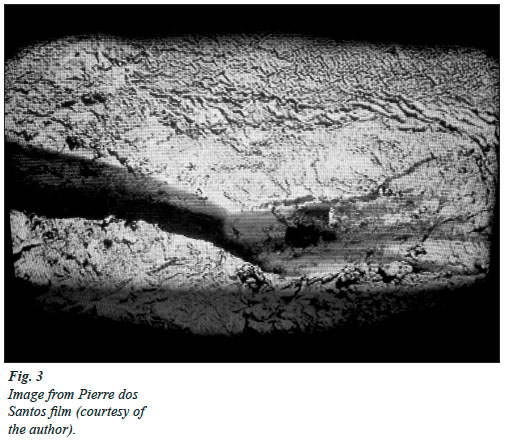
Display large image of Figure
3
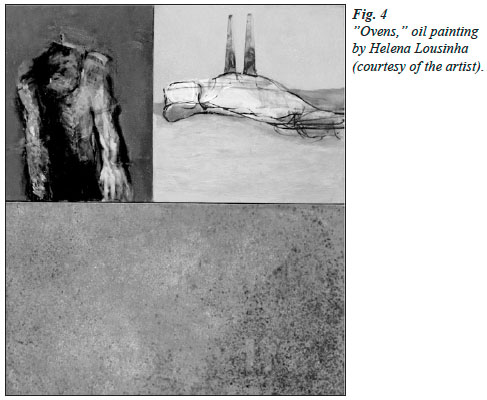
Display large image of Figure
4
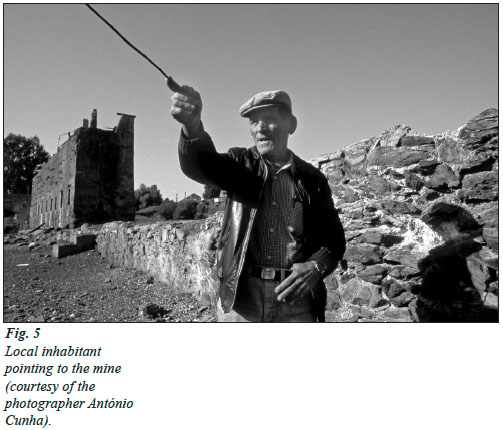
Display large image of Figure
5
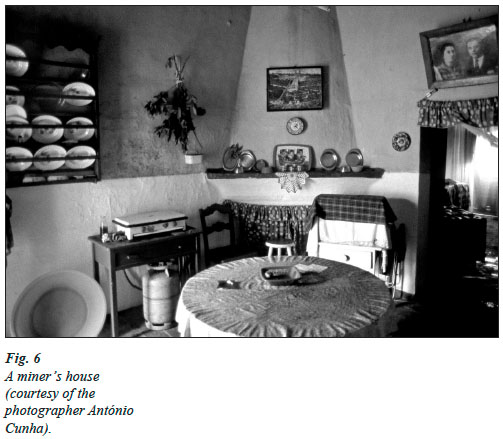
Display large image of Figure
6
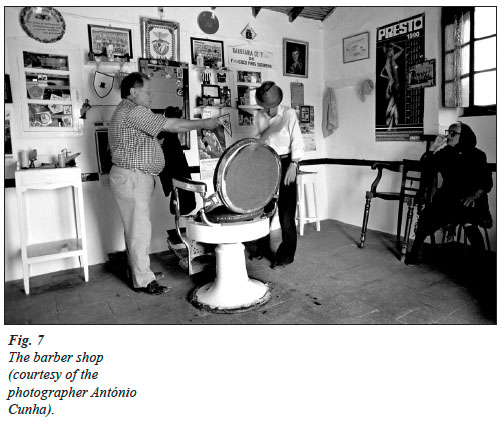
Display large image of Figure
7
27 The long period of complete public oblivion and disregard for the mine and the village are also addressed by Cunha in his many photographs of the abandoned, derelict or vandalized mining facilities, with equipment set in its original contexts. The photograph of the rusty derailed wagon (Fig. 9) left in the middle of the tunnel, at the end of which a tiny sparkle of daylight can be detected, provides a potent metaphor for the contemporary situation of the village. Moreover, it offers a most interesting contrast to the actual wagon, displayed in the commemorative exhibition, and significantly put back on track.
Guidebook of the Mine, by António Martins
28 Roteiro da Mina: Mina de S. Domingos (Guidebook of the São Domingos Mine) by António Martins, a former miner, was self-published on the occasion of the mine’s anniversary in 2004. It was sold at the exhibitions and provided a shocking contrast to the "official" account of the village’s history. The title is misleading, as it addresses what Martins (2004: 7) refers to as the "bitterest memories." Documenting the author’s thirty years of living in São Domingos (1930 to 1960), Martins deals with those aspects of daily life the organizers of the exhibitions failed, or chose not, to represent. The book’s declared objective is to offer an informed account of the miners’ lives, of "the times of misery and relentless suffering borne by the humble people of São Domingos Mine" (8). The cause of such distress is blatantly pointed out in the book’s conclusion: the company administration, "the exploiters [who] used thousands of human beings, men and women, at whim and forced them into consent, given the impossibility of complaining about the abuses committed against so many unprotected people" (105). The author is indirectly referring to the dictatorial regime which ruled Portugal between 1933 and 1974, and to the authoritarian government’s unconditional support of the company, especially in the fierce repression of the miners’ organized action.
29 António Martins’s book is not just about the exploited labour of the miners, but offers instead a comprehensive account of the spaces, ways of life, institutions, daily routines and everyday practices of this working-class community. The guidebook’s points of reference include the mining company, the director’s residence, the British staff, the police, the miners’ quarters, the public toilets, the miner’s wife, Christmas Day, dating customs, the taverns, the funerals, the sulphur factory, pay day, football, the killing of the pig, the excluded—among others. Álvaro Pina has emphasized the difference between community as concept "…a place, or a formation, where one feels at home… " and "communities as practices, with their contradictions and conflicts" (2004: 194-95). Whereas the exhibitions focus on the former meaning of community, António Martins’ account emphasizes the latter with his references to alcoholism, domestic violence, suicide, fear of the police, children’s resistance to taking a bath, for example—those most intimate aspects of daily life.
São Domingos and "The Heritage Debates": Other Places, Similar Stories?
30 Globalization is a complex and uneven process, in both spatial and temporal terms. The history of São Domingos partly replicates that of numerous industrial and mining towns in other temporal and geographic locations. In this context, some of the points made here resonate with Britain’s intellectual debates on heritage that occurred in the 1980s and 1990s within the context of widespread de-industrialization and the almost immediate refashioning of redundant industrial workplaces into tourist attractions. The debate was greatly triggered and fuelled by a very explicit political appropriation of heritage, as the concept was mobilized by Margaret Thatcher’s government, with simultaneous cross purposes: on one hand, it attempted to combat a perceived crisis in national identity brought about by, among other factors, de-industrialization, the loss of the "empire" and the integration into the European Union. On the other hand, heritage played a crucial role in economic restructuring, in the remaking of "Great" Britain.
31 The debate centred on various strands of two main issues which have been broached above: first, the expansion of the concept of heritage to include "the people’s history" and the inclusion of industrial heritage sites in the canon of national heritage; and second, the problematic ways in which the "the past," "history" and "memory" were represented in the displays and collections of the newly developed, mainly industrial, heritage sites. Early critics such as Patrick Wright (1999) and Robert Hewison (1987) blamed heritage for conveying a disabling view of British history as a process of decline, contrasting a glorious and irreplaceable past with a shameful—post-industrial and post-imperial—present. These authors also criticized national heritage for conveying an abstracted and distorted version of history. Raphael Samuel regretted the Conservative appropriation of the notion of heritage, which retrospectively opened the nation to the excluded, paradoxically facilitated by the sustained effort of socialist historians to rehabilitate popular history. Despite this, he welcomed the broadening of the concept to include popular culture and retrospectively dignify not only male industrial, but also feminine domestic labour: "The new version of the national past … is inconceivably more democratic than earlier ones, offering more points of access to ‘ordinary people,’ and a wider form of belonging" (Samuel 1999: 177).
32 Drawing on Beamish—The North of England Open Air Museum—Tony Bennett (1988: 64) focused on how the history and the memory of the region’s working class was misrepresented, indeed silenced and "mortgaged to the dominant culture." According to Bennett , the fact that the objects and artifacts assembled at Beamish had in fact been severed from their original spatial, temporal and popular political contexts and presented as a unified, frozen-in-time picture of "the northern experience" (69) only added to the museum’s deeply distorted—albeit official—version of the region’s industrial history. Moreover, he is critical of the museum’s idealized depiction of the working class: "It embodies the people—but the people as envisaged within the dominant culture; as a regional folk which is as endlessly cheerful and good-natured as it is enterprising and industrious" (65).
Fig. 8 At the cemetery with a poodle (courtesy of the photographer António Cunha).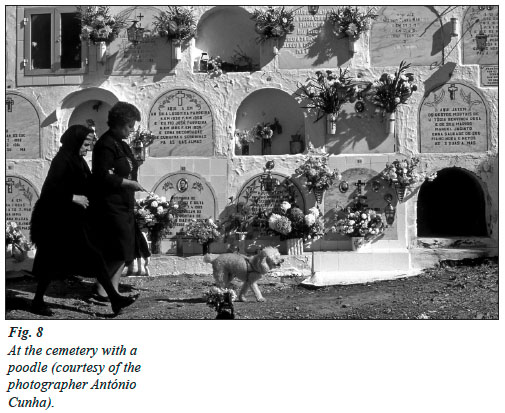
Display large image of Figure
8
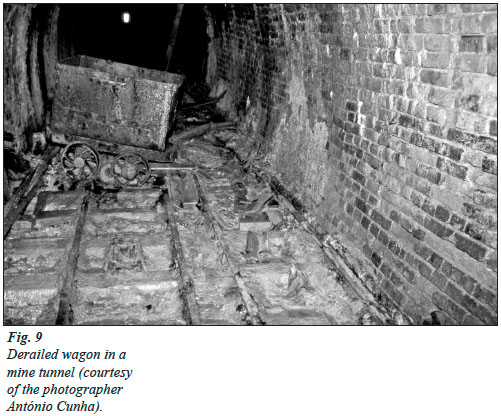
Display large image of Figure
9
33 In his analysis of the Ironbridge Gorge Museum, Bob West (1988: 59) similarly recognizes the contribution of industrial heritage sites to "popularizing ‘the past’ as an available form of knowledge" but clearly distinguishes between "‘the past’ with its sinister inverted commas" (37) that was conveyed at Ironbridge—a stylized, romanticized, mythologized, sanitized and deeply commodified past—and history, with its progressive potential to "tell[ing] the past as a different story; a story perhaps to inform the present of progressive ideas and struggles against the old oppressions of class, race, and gender" (37-38). He also denounces the commercially minded purposes behind the inclusion of industrial heritage in the "officially sanctioned" notion of "English Culture" (42), which he dubs "the professional-managerial perception of industrial history" (59).
The São Domingos Exhibitions and the (Re)construction of the National Industrial Past
34 How do these ideas, and the debates on heritage, bear upon and help us make sense of the São Domingos exhibitions as representational systems, as narratives of the history of the village and the people, as discourses of the local and national industrial past? And in what ways did the objects, images and texts of the São Domingos exhibitions interact to produce, reinforce or question and oppose these narratives and discourses?
35 The commemorative exhibitions did play a crucial role in making the history of the São Domingos’ mining community available to the wider public, something that the few existing (and mainly academic) writings on the mine have failed to accomplish.11 The 150 Years of History exhibition provided a general overview of the modern history of the mine’s exploration and dignified the hard labour of the miners. The relatively small number of objects on display, framed by the leaflet’s explanation that they had mostly been salvaged from the rubbish heap, supported the fact (also stated in the leaflet) of the utter abandonment and deprivation the village and its people were subjected to after the closing of the mine. Together with the other commemorative events, the exhibition helped put the village back on the national map and rehabilitated the memory of this important mining community.
36 However, its main and pervasive narrative was that of the historical national significance of the first large-scale, state-of-the-art industrial venture undertaken in Portugal, and of its decisive contribution to the North European and North American industrial revolutions. This was accomplished not only through the key objects and oversized photographs selected for display—and how they were arranged and interrelated—but also through the tight control of the visitors’ interpretations effected by the texts (both on the posters and in the exhibition leaflet), which authoritatively explained the meanings of the objects and the photos. The lack of biographical information on both the objects and the pictures also contributed to a unified and static picture, or glimpse, of the village’s—and the country’s—industrial history and past, to the objectification of industrial work. The wagon (Fig. 1), detached from its original setting and restored, contributed to that intended effect, producing very different meanings from António Cunha’s photograph of the wagon in situ (Fig. 9).12
37 Both exhibitions—but particularly the second—addressed the appalling conditions of the workers’ quarters (a miner’s house consisted of a sixteen square-metre windowless room), the long shifts and the dangerous back-breaking work, the frequent mining accidents and illnesses and the workers’ demands for better working and living conditions. However, these were at the same time somewhat naturalized, implicitly justified by "the way things were" back then. This idea was enhanced by the almost complete absence of information on the British-owned company that explored the mine and on the small British community that existed there throughout its 112-year history.13
38 The exhibitions presented an overall sentimentalized, mythologized and static vision of a working-class community that decisively contributed to the industrial development of the "advanced" far-way countries of Northern Europe and America. The miners’ organized struggle was displayed in the painfully long, hardly readable texts, but counterpointed, and effectively neutralized, in the film’s commentary, which portrayed riots and violence stereotypically, either as endemic to the mining communities or else incited by a few agitators. James Mason, the founder of Mason and Barry, is praised in the film for his "engineering and management expertise" in the building of this "great industrial centre" (Verde 1997).
39 The exhibitions also downplayed and neutralized the real tension and conflict between the British administration and the Portuguese workers (a constant trend in the history of the mining exploration) and the profound cleavages that separated the workers from the British community who, in the best imperial style, lived comfortably in exclusive residential quarters and enjoyed equally exclusive amenities and pastimes. The text of the leaflet evokes the philharmonic orchestra’s performance at the bandstand in the "administration garden" but omits the fact that this was not a public space for most of the time the mine was operated. The cricket ball is unproblematically placed next to the musical instruments (Fig. 2) in a glass case that seemingly aims to depict the mining population’s leisure. This constitutes perhaps one of the most significant "cracks" in the exhibition, as the cricket ball potentially acts as a deeply awkward, destabilizing element of the overall dominant narrative which projects a (false) picture of tranquil coexistence between management and workers, of "a utopian national whole that harmoniously integrates ... diversity" (Kirshenblatt-Gimblett 1998: 20). This, however, does not depend on the ball alone, but requires the visitor’s "cultural capital."14
Fig. 10 Local women at the market, 150 Years of History exhibition—cover photograph (courtesy of Fundação Serrão Martins/Câmara Municipal de Mértola).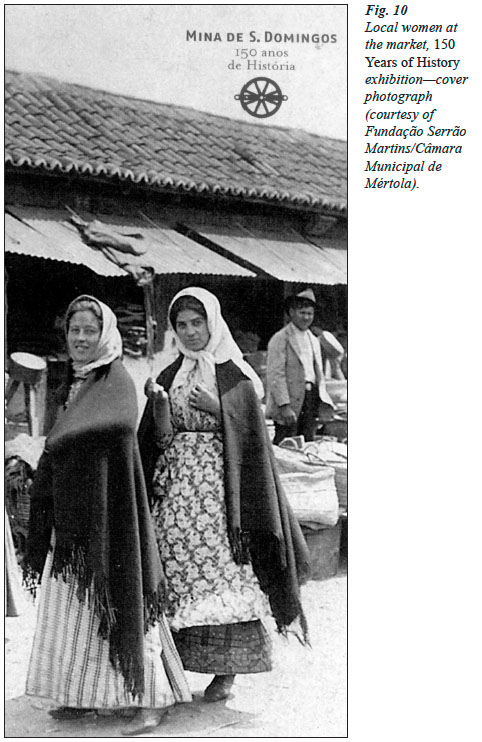
Display large image of Figure
10
40 Both the film and the exhibitions also conveyed the implicit but pervasive idea that despite the human cost of the mining enterprise, those were indeed better times: people had jobs and São Domingos was a modern bustling town. The selected photographs played a crucial role here, producing a similar effect to that of French humanist photography which, according to Peter Hamilton (1997: 147), helped construct "a particular composite national identity ... [which] was provided with representational legitimacy by the apparent objectivity of the camera-produced image." Hamilton also notes how, in the context of a massive traumatic de-industrialization process, French humanist photography contrasted contemporary national insecurity with an idealized image of the nation’s past and identity: "... life ‘then’ appears to be a ‘golden age’: hard, but rewarding, not bereft of conflicts and disputes, but warm and communal—a sense in which everybody shared the hardships of the era..." (148).
41 This idea was conveyed in the photographs selected and displayed at the exhibitions and particularly striking in the image chosen for the exhibition’s leaflet (Fig. 10), where two happy, healthy, well-clad young (working-class) women stroll in the marketplace and smile at us from an idyllic (industrial) past age. There is an acute contrast between this picture and the lived experiences narrated by António Martins in his Guidebook; the experience of real and acute material deprivation, of physical abuse by a drunken husband or father, or the despair at a husband’s death in a mining accident and being left with several children to feed. In this context, Samuel (1999: 179) once remarked how old photographs could be used to support conservative (and idealized) views of the past: "It is difficult to think of the family in terms of oppression and insecurity when photographs testify to its stability and grace."
42 The film, Biography of a Mine, similarly draws attention to the spatial and temporal dichotomies, contrasting the development of the industrial town with the backwardness of the surrounding rural world. The dynamic black and white scenes of happy and noisy children at the end of a school day and of strong miners pushing heavily-loaded wagons sit in opposition to the sad, immobile, silent, elderly inhabitants of the present-day decayed, semi-deserted village. The phrase "but this all belongs to the past" is continually repeated, stressing the irredeemable pastness of the industrial experience, even of the people, as if they were already dead. For all the memories the exhibitions overtly set out to voice, the subjects of the exhibitions, the few existing people who could contribute to an informed account of their own and their direct ancestors’ experiences, are silenced and subordinated to the authoritative, neutral, monotone Received Pronunciation (RP) voice-over of the film’s narrator.15
43 The heritage debates and the arguments briefly considered above help us grasp some of the problems and indeed limitations and contradictions of the São Domingos Mine’s first two exhibitions and film—namely the depiction of the village’s history as a process of decline, the idealized representation of the working-class community and the attempt to harmonize the working-class political culture grounded in oppositional structures and institutions with the dominant bourgeois conception of industrial progress and to "a corporate employers’ vision of history" (Bennett 1988: 72). Most importantly, however, the silencing of the local people’s own narratives—those "thousand stories" the "anonymous people with names" (Rego 2004a) could have told—speaks directly to the problems, limitations and contradictions of both the commemorative exhibitions and the film.
Other Gazes Upon the Past and the Present
44 By contrast, António Martins’s book and the joint exhibition by Dos Santos, Lousinha and Cunha voice the experience, the memory, the lived culture of the nameless and wordless people displayed in Biography of the Mine. They also represent many of the film’s and the exhibitions’ fault lines and absences, such as the human consequences of the mine’s closing and the unresolved environmental problem of the acid water deposits. The past they narrate does not end with the closing of the mine— neither do the lives of the people or the village. Unlike the first two exhibitions or the film, both António Martins and António Cunha address the past that was the future after the mine.
45 António Martins tells us about the return of those who had left the village, the improvements in the modest houses and, more broadly, in the living standards of the people. Though the present is not the issue of his unusual guidebook, it is clear that, for this former miner, the village’s and the people’s present is infinitely better than—though permanently haunted by the memory of—those terrible past times. Finally, the past addressed by these authors (unlike that of the two first exhibitions) is not static, fixed or left behind. Memories are communicated because they bear on the present and with the aim of questioning not only the past but especially the present and the future of the village, the people and their heritage.
Conclusion
46 The development of cultural (and historical) tourism within a general trend of unprecedented tourism growth, the creation and expansion of new forms of heritage (namely industrial), the concurrent restructuring of the very concept of heritage to incorporate them, the several changes museums have undergone in the last two decades and the boom in critical thinking on the meaning of heritage, museums, or even "the nation," within both traditional and new academic and research fields,16 have to be understood within the framework of global transformations effected by the ongoing "international restructuring of capitalist economies" (Robins 1999: 17).
47 The simultaneous—and fundamentally new— dual use of heritage as cultural and economic capital is problematic (Graham et al. 2000: 22). In the process of commodification for global tourism, heritage often becomes "the material embodiment of the nation" (Hall 2005: 23-24) and can be made to tell an official version of the collective that is partial, distorted and eminently conservative—even mythic. National and local history and identity sometimes bear little resemblance to the reality of the past: "a perfect copy of a history that never existed" as Hewison (1991: 174) would say. Kirshenblatt-Gimblett uses the term "dystory" to describe "history as it should have happened" and likens tourism to the "dystory business" (1998: 175).
48 Moreover, industrial heritage’s representation of a bygone, sealed off industrial past and its emphasis on the pastness of crafts, modes of social organization and ways of life, sustains and reinforces a certain discourse on the end of the modern era, on the death of industrial society and (implicitly) of all its profoundly negative human, social and environmental consequences. However, de-industrialization, economic restructuring and their complex and intricately related social ravages and cultural transformations are a historically enduring global problem, of which São Domingos, like countless other sites around the globe, remains a painful living proof. While the São Domingos’ miners are retrospectively dignified in the museum, the region’s existing miners are falsely accused of stealing explosives and of selling them to international terrorist networks (Dias 2006: 61).17 Names and memories of dead miners are glorified in museum displays while countless nameless others still perish in mines around the globe, in "a historical process that changes just to remain the same" (West 1988: 60).
49 Christopher Tilley argues that "the interpretation of meaning and significance of material culture is a contemporary activity. The meaning of the past does not reside in the past but belongs in the present" (1994: 73). Objects and images can be "singularized" and purposefully arranged and combined to create, foster and reinforce dominant narratives and discourses in the present. However, cultural artifacts are endowed with a "surplus of meaning" (Davison 2005: 193), which is the source of their continuous tension and destabilization of the displays’ constructed coherence. Issues of context and the inescapable unpredictability of the visitor’s critical response to, and active interpretation of the display are additional and important disruptive elements (Tilley 1994: 72).
50 But tourism, heritage and material and visual culture can also be harnessed in more socially and culturally democratic, pluralistic and challenging ways. A growing number of museum scholars and practitioners underline the social role and responsibility of museums in contemporary societies, and the "generative" potential of their representations (Sandell 2002). The "capacity of objects to stimulate social changes" (Pearce 1994: 2) as they move to the museum or exhibition context is real but not an intrinsic feature of the objects per se, it has to be fulfilled: "it is the use made of these objects and their interpretive frameworks that can open up or close down historical, social and cultural possibilities" (Sandell 2002: 8).
51 This, however, as Jo Littler (2005: 7) has recently emphasized, requires a different, more open conception of heritage, both in temporal and geographic terms. It entails not only drawing links between the past and the present, but also looking at the ways local, national and international heritages intersect (8). It entails acknowledging (not writing off) difference, rupture and conflict as inherent characteristics of any form of collective belonging, particularly the nation. It involves a fundamental shift in the ways history, heritage, material and visual culture—the arts and humanities in general— are conceived and put to use in contemporary societies, to harness not only their undeniable economic, but mostly their social and cultural potential.
52 Thousands of visitors come to São Domingos every year, especially in summer. Most have biographical ties to the village and its past, and come not to (re)visit its heritage but to meet family and friends and enjoy the pleasures of the river beach.18 For São Domingos residents or those of the wider region, economic regeneration remains an unfulfilled promise, a dim light at the end of the tunnel. The many projects announced in 2004—the year of the village’s anniversary and of the campaign for the local election—seem to have been put on hold until further notice. The exhibitions have closed and the aim of the Gazes Upon a Place artists and curator—to reinstate the debate on the village’s future—has failed. Meanwhile, a "thousand stories" wait to be told: most notably, those that approach the complex, fundamentally supranational, character of both the national and the local history, and the diverse hybrid cultural forms, diasporic experiences and human trajectories that primarily make up not just São Domingos’s, but Portugal’s past and present identity.
References
Appadurai, Arjun, ed. 1986. The Social Life of Things: Commodities in Cultural Perspective. Cambridge: Cambridge University Press.
Bennett, Tony. 1988. Museums and ‘The People.’ In The Museum Time Machine: Putting Cultures on Display, ed. Robert Lumley, 63-85. London and New York: Routledge.
Bourdieu, Pierre. 1984. Distinction: A Social Critique on the Judgement of Taste. Trans. R. Nice. Boston: Harvard University Press.
Castanho, Jorge. 2004. Mina de S. Domingos: 150 anos de História – Monumento ao Mineiro (Des)conhecido. Monument’s Sketch Book. Mértola: Câmara Municipal de Mértola.
Checkland, S. G. 1967. The Mines of Tharsis: Roman, French and British Enterprise in Spain. London: George Allen and Unwin.
Corner, John and Sylvia Harvey, eds. 1991. Enterprise and Heritage: Crosscurrents of National Culture. London: Routledge.
Cunha, António et al. 2006. Mina de S. Domingos: Olhares sobre um Lugar. Exhibition Leaflet.
Davison, Patricia. 2005. Museums and the Re-shaping of Memory. In Heritage, Museums and Galleries: An Introductory Reader, ed. Gerard Corsane, 184-94. London and New York: Routledge.
Graham, Brian, Gregory J. Ashworth and J. E. Turnbridge. 2000. A Geography of Heritage: Power, Culture and Economy. London: Arnold.
Guimarães, Paulo. 1996. O Alentejo e o Desenvolvimento Mineiro durante a Regeneração. In Mineração no Baixo Alentejo, org. Miguel Rego, 114-29. Castro Verde: Câmara Municipal de Castro Verde.
Hall, Stuart, ed. 1997. Representation: Cultural Representations and Signifying Practices. London: Sage.
———. 2005. Whose Heritage? Un-settling ‘the Heritage’, Re-imagining the Post-nation. In The Politics of Heritage: The Legacies of ‘Race’, eds. Jo Littler and Roshi Naidoo, 23-35. London: Routledge.
Hamilton, Peter. 1997. Representing the Social: France and Frenchness in Post-war Humanist Photography. In Representation: Cultural Representations and Signifying Practices, ed. Stuart Hall, 75-150. London: Sage.
Hewison, Robert. 1987. The Heritage Industry: Britain in a Climate of Decline. London: Methuen.
———. 1991. Commerce and Culture. In Enterprise and Heritage: Crosscurrents of National Culture, eds. John Corner and Sylvia Harvey, 162-77. London and New York: Routledge.
Hobsbawm, Eric. 1999. Mass-producing Traditions: Europe, 1870-1914. In Representing the Nation: A Reader. Histories, Heritage and Museums, eds. David Boswell and Jessica Evans, 61-86. London: Routledge.
Kellner, Douglas. 1997. Critical Theory and Cultural Studies: The Missed Articulation. In Cultural Methodologies, ed. Jim McGuigan, 12-41. London: Sage.
Kirshenblatt-Gimblett, Barbara. 1998. Destination Culture: Tourism, Museums, and Heritage. Berkeley: University of California Press.
Kopytoff, Igor. 1986. The Cultural Biography of Things: Commoditization as Process. In The Social Life of Things: Commodities in Cultural Perspective, ed. Arjun Appadurai, 64-91. Cambridge: Cambridge University Press.
Lidchi, Henrietta. 1997. The Poetics and the Politics of Exhibiting Other Cultures. In Representation: Cultural Representations and Signifying Practices, ed. Stuart Hall, 151-208. London: Sage.
Littler, Jo. 2005. Introduction: British Heritage and the Legacies of ‘Race.’ In The Politics of Heritage: The Legacies of ‘Race’, eds. Jo Littler and Roshi Naidoo, 1-19. London: Routledge.
Macdonald, Sharon, 1998. Exhibitions of Power and Powers of Exhibition: An Introduction to the Politics of Display. In The Politics of Display: Museums, Science, Culture, ed. Sharon Macdonald, 1-24. London: Routledge.
Martins, António. 2004. Roteiro da Mina: Mina de S. Domingos. Estoril: Self- published.
Meethan, Kevin. 2001. Tourism in Global Society: Place, Culture, Consumption. Basingstoke: Palgrave.
Morley, David and Kevin Robins. 2001. British Cultural Studies: Geography, Nationality and Identity. Oxford: Oxford University Press.
Pearce, Susan, ed. 1994. Interpreting Objects and Collections. London: Routledge.
Pina, Álvaro. 2004. Culture, (the Conduct of) Freedom and (the Phobia of) Community. In Culture & Power: Phobias, eds. Cristina Andreu and Pere Gallardo, 193-209. Tarragona, Spain: Silva.
Rego, Miguel. 2004a. Mina de S. Domingos: 150 Anos de História. Exhibition Leaflet. Mértola: Câmara Municipal de Mértola.
———. 2004b. Mina de S. Domingos: 150 anos de História – Fotogramas da Memória. Exhibition Photo Book. Mértola: Câmara Municipal de Mértola.
Robins, Kevin. 1999. Tradition and Translation: National Culture in its Global Context. In Representing the Nation: A Reader. Histories, Heritage and Museums, eds. David Boswell and Jessica Evans, 15-44. London: Routledge.
Rosenthal, Gisela. 2006. Olhares sobre um Lugar. Exhibition Leaflet.
Samuel, Raphael. 1999. Resurrectionism. In Representing the Nation: A Reader. Histories, Heritage and Museums, eds. David Boswell and Jessica Evans, 163-84. London: Routledge.
Sandell, Richard, ed. 2002. Museums, Society, Inequality. London: Routledge.
Tilley, Christopher. 1994. Interpreting Material Culture. In Interpreting Objects and Collections, ed. Susan Pearce, 67-75. London: Routledge.
Urry, John. 2002. The Tourist Gaze. London: Sage.
Verde, Filipe, dir. 1997. Biography of a Mine (film). Lisbon and Paris: Cobra Filmes, Lanterna Mágica and Dominant 7, prods.
West, Bob. 1988. The Making of the English Working Past: A Critical View of the Ironbridge Gorge Museum. In The Museum Time Machine, ed. Robert Lumley, 36-62. London: Routledge.
Williams, Raymond. 1992. The Long Revolution. London: The Hogarth Press.
———. 1993. Culture and Society. London: The Hogarth Press.
Wright, Patrick. 1999. Trafficking in History. In Representing the Nation: A Reader. Histories, Heritage and Museums, eds. David Boswell and Jessica Evans, 115-50. London: Routledge.
Notes